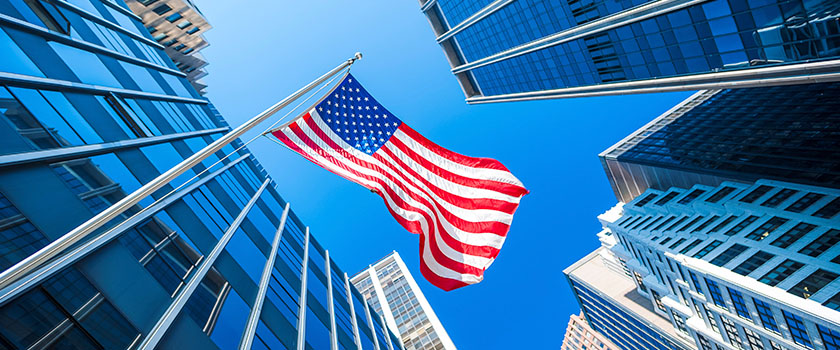US 10-year Treasury yields have risen 110 bps from their July, 2020 lows and 60 bps alone in 2021. Using previous bond market ‘tantrums’ going back to 2008 as a reference, a rise to as much as 1.7-2.5% may still lie ahead should the turmoil resume.
Key points :
- While US equity markets have absorbed the move to 1.3-1.4% in 10-year yields reasonably well, not least thanks to better-than- expected corporate earnings, further increases in yields, especially at the pace seen in February leave US equities expensive relative to Treasuries and Baa credit, unless we see further upgrades to earnings expectations.
- Though some may hope for Fed intervention to slow the rise in Treasury yields, the fact that financial conditions in the US remain loose with few signs of dislocation in credit markets, even with the sharp rise in yields, direct policy intervention appears unlikely at this juncture.
- Instead, the US Federal Reserve may want to formally handover policy leadership to the US Treasury. The imminent release of as much as USD 1.9 trillion in additional relief from the US Congress suggests further turmoil in the weeks ahead.
- As a result, stock selection focused on upside surprises to earnings remains key in order to offset potential pressure on P/E multiples that may emerge with a rising yield environment.
- Investors should use this volatility as an opportunity to balance the transformational growth themes that will serve as the foundation for the post-pandemic global economy with quality cyclical recovery companies that should drive the next leg of earnings recovery through 2021.
How much higher can bond yields go?
Our expectation for the recovery of US 10-year yields was that the Federal Reserve would be interested in preventing a 2013-style ‘Taper Tantrum’ in yields that could potential destabilize overall financial conditions in the US economy.
In retrospect, our expectations of a pro-active Fed policy to avert such a 2013-style surge in yields was misplaced. Instead, it appears the pro-active policy stance of 2020 has now given way to a more traditional reactive policy stance in 2021.
More specifically, though 10-year Treasury yields have surged, with credit spreads contracting in response to near cyclical tights in both investment grade and high yield bond markets, overall financial conditions remain surprisingly easy in spite of the turmoil in Treasury markets.
Indeed, the 110 bps rise in 10-yr yields from the July, 2020 lows still leaves risk-free yields short of the 120-140 bps typical of similar bond market tantrums since 2010. Moreover, the rise in yields from the pandemic lows remains short of the 200 bps seen as the US economy emerged from the 2008-09 Global Financial Crisis.
Were Treasury yields to replicate these moves, another 10-90 bps (1.7-2.5% in nominal yield) would lie ahead. Indeed, given that financial conditions are still rather loose on balance, supported as they are by tightening credit spreads and, until recently, falling volatility, as the March policy meeting approaches the Fed appears comfortable with a reduction in the exuberance that has built up in markets year-to-date.
Thus, investors should not be surprised to see US 10-year yields keep rising in weeks ahead, perhaps until overall US financial conditions become neutral or even modestly tightening. Without this, it appears unlikely that the Fed might pursue some form of Japan’s or the euro area’s yield curve control strategies ahead of the mid-March policy meeting.
Indeed, framing the current rise in bond yields against the backdrop of a return to pre-pandemic ‘normal’ conditions, US and German P/E’s look similar to pre-pandemic 2019 peaks. Crude oil has priced in a cyclical recovery like in late-2019, while copper prices indicate a more robust recovery cycle. Indeed, even German 10-year yields have returned to their late-2019 levels, while US 10-year yields remain nearly 20 bps short
of their levels before the pandemic began in early-2020.
Thus, should US Treasury yields return to the range that emerged following the easing of US-China Trade War tensions in late-2019, a range of 1.5-2.0% would be the new range for the benchmark yield.
The catalyst for this rise in yield has undoubtedly been the growing expectations of an increase in inflationary pressure as US fiscal measures are set to be deployed and the benefits of an accelerating vaccine rollout are anticipated moving into the spring.
As we have outlined previously, looking at inflation adjusted yields is a valuable approach to gauging the Fed’s policy trajectory.
With most expecting US inflation to accelerate in the months ahead and taking the Fed at their word that they wish to maintain an ‘accommodative stance of monetary policy’ until both its inflation and employment objectives are achieved, the rise in nominal yields to date suggest that markets are anticipating a rise in core PCE inflation from the 1.4-1.5% seen in recent months to the Fed’s target of ‘inflation moderately above 2 percent’ in the months ahead.
Should the Fed want to keep inflation-adjusted interest rates negative as inflation rises, nominal yields could stabilise closer to 2%. Given the substantial leverage in the economy, both in the US and around the world, we believe negative inflation adjusted yields are a viable strategy to allow for an erosion of the nominal debt stock looking forward.
Admittedly, risk exists that if instead, the Fed is comfortable handing policy leadership to fiscal authorities and inflationadjusted 10-year yields follow the same trajectories as seen in economic recoveries in the current century, a move to beyond 3% would be necessary as inflation re-emerges.
Thus, across a number of axes, absent a new demand shock in the US or the global economy, US yields appear to have begun at least a cyclical liftoff and confidence builds that the Fed objective of 2-2.5% inflation is achievable. For bond investors, this probably means that a further increase in yields is likely towards the 2% area (assuming the Fed continues to target negative inflation-adjusted yields) with risk towards 3% should a more normal reaction function be at play.
For bond investors, while a short duration bias remains prudent to protect against the rising yield environment, the search for returns keeps pushing us off the US dollar yield curve towards European bank hybrids which offer high yield-like returns without the magnitude of rising rate risk seen in US dollar bond markets. Similarly, our China government bond exposure has weathered the US bond market tantrum well, with a stable yield backdrop and premium carry offered to investors in Chinese yuan-denominated sovereign debt.
What do higher bond yields mean for equity investors?
With robust earnings growth and on-going upgrades to earnings expectations, we had been comfortable that a cyclical recovery in 10-year yields to the 1.3-1.5% range could be accommodated by US equity markets.
With the push to 1.6% in the benchmark US Treasury yield, US equities look expensive in comparison. Indeed, with the tantrum in Treasury markets also putting upward pressure on US corporate bond yields, with Moody’s Baa yields reaching 3.6%, equities appear increasingly expensive relative to investment grade credit as well.
Thus, should Treasury and Baa yields keep going up, there is a risk of a further de-rating in US equity multiples. Without further upgrades to earnings expectations, based on these frameworks a move towards 2% on US Treasury yields would require a further 15-20% fall in the S&P 500 to return to fair value.
However, expectations for corporate earnings in the 1st quarter keep increasing, which should provide at least a partial offset to the multiple contraction that should continue in the months ahead.
Indeed, the greater-than-expected stimulus will boost the earnings of traditional cyclical players, while the normalization of interest rates to pre-pandemic levels should give financials, which had seen earnings momentum lag, a tailwind in the quarters ahead.
As a result, the relatively calm markets since the US Presidential elections of 2020 – driven by rising earnings expectations and complemented by steady P/E multiples – should now give way to a more volatile backdrop that is still driven by improving earnings prospects but subject to volatility via a normalization of valuations and of the broader interest rate environment.
Thus, though earnings prospects have been a key to identifying equity opportunities in 2020 and 2021, their importance will take on even greater importance looking ahead.
Indeed, unlike 2020 when traditional growth sectors of healthcare, technology and communications held a monopoly on earnings growth, especially in the US, in 2021, though those sectors will continue to deliver steady and respectable growth, cyclical sectors have begun to show the earnings leadership that is typical at this stage of the economic recovery.
In recent years, earnings seasons amongst mature growth companies have typically seen better than expected earnings, unlevered balance sheets, strong free cash flow driving rising dividends and increased buybacks. We expect this trend to continue in the quality growth segment of the market.
However, the recently completed earnings season highlighted a similar trend that’s beginning to emerge in select cyclical sectors. The global mining sector that has spent the past few years deleveraging and recapitalizing its balance sheet, is benefiting from the rising commodity prices brought about by the cyclical recovery underway. This is being reflected in better than expected earnings and stronger than expected free cash flow growth, leading to rising dividends and the prospect, later in the year for select companies, of increased buybacks.
UK banks have showed a glimpse of the same in their recent earnings reports, with dividends being restored following the cancellation of dividends across European banks in 2020.
Thus, though more rather than less volatility likely lies ahead, investors should use this volatility as an opportunity to continue to transform their equity holdings, balancing the transformational growth themes that will serve as the foundation for the postpandemic global economy with quality cyclical recovery companies that should drive the next leg of earnings recovery through the balance of 2021.
Pro-active risk management increasingly required
Despite our optimism with regards to the global economic recovery prospects, as highlighted earlier, the reaction of the Federal Reserve remains uncertain. Should they entirely handover their policy leadership to fiscal authorities and allow long-dated yields to normalize properly, it may be difficult for corporates in the US and around the world to generate sufficient earnings surprises to offset the potential P/E compression.
As a result, pro-active protection strategies should remain the foundation of investors’ portfolios looking ahead. Indeed, as optimism was building in January and even in February, both equity and bond volatility returned to the pandemic-era lows, meaning that the market was presenting an opportunity for investors to add protection cheaply against renewed bouts of volatility in markets as seen in recent days.
While useful in cushioning the even temporary drawdowns in markets, they are even more valuable in allowing investors to maintain exposure to key long-term themes and companies which one otherwise might be forced to exit during periods of volatility in order to manage overall risk.











